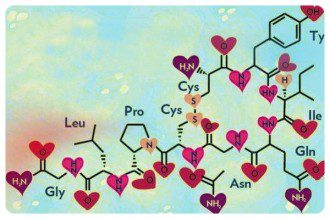By Razi Berry
Guest writer for Wake Up World
Humans are social animals. We naturally bond and pair as couples in partnerships and marriage. We live together as families and tribes, and we gather as communities. No doubt this is a manifestation of our spiritual selves which are never alone. This concept has many forms of dress. We call it our connection to God, or with our higher Self, or our oneness with Nature. In some religious traditions, we are all spiritual children of the Creator, or the Great Spirit. In others, as in Kabbalistic traditions, we originate from sparks of one light.
This tradition offers a beautiful illustration of how we are connected to one Source. It tells of a Godhead, an infinite, all permeating light with no beginning or end that filled the entire universe with no empty space. Out of a divine will, the Infinite, contracted Itself unto Itself to create a space where there was only fullness. Ten vessels (Sefirot) were then formed to hold this light. These vessels are said to be filled with the light of ten attributes of how God reveals himself to us, and to Himself. The attributes are:
[pro_ad_display_adzone id=”110028″]
• Chochmah: wisdom
• Binah: understanding
• Daat: knowledge
• Chessed: kindness
• Gevurah: strength
• Tiferet: beauty
• Netzach: victory
• Hod: splendor
• Yesod: foundation
• Malchut: kingship
These attributes may also be viewed as longings we hold as humans. One could argue that these attributes are more easily understood in the context of a relationship than in separateness.
This story beautifully continues that the vessels were not able to hold such emanating light, and shattered. The resulting sparks created souls-the worlds we both know and don’t know, as well as humanity. In a much-oversimplified way, I am explaining that we are created from these sparks of everything, of the Will of God. That we are not alone. And in both physical and spiritual ways we, as humans and as souls, seek to connect with each other. We don’t always do it elegantly, but we are always seeking connection because it is our very nature to be connected.
When we are unable to make this connection, as in consequences of departing from nature, we suffer. The inability to connect causes loneliness, which we are finding has deep implications to our spiritual, mental and physical health.
The following outlines the ways loneliness affects our health:
Predictors of Loneliness
Loneliness is proven to be harmful to our health, and identifying these predictors early can keep us healthier for longer. A recent study, Correlates of social and emotional loneliness in older people: evidence from an English community study, randomly recruited around 1200 adults, aged 65 and older, from a sampling frame and were given a questionnaire to identify the precursors to loneliness. The study resulted in 7.7% of adults feeling severely lonely and 38% of adults were moderately lonely. “Being male, being widowed, low well-being, low self-esteem, low-income comfort, low contact with family, low contact with friends, low activity, low perceived community integration, and receipt of community care were significant predictors of social loneliness.” Identifying how chronic loneliness begins is key in preventing it from affecting your health.
Loneliness and Chronic Illness
Loneliness and Quality of Life in Chronically Ill Rural Older Adults is a study that surveyed 60 chronically ill people face-to-face in determining how loneliness and chronic illness correlate. Using the UCLA loneliness scale and the CASP-12 quality of life scale, the survey examined loneliness and quality of life, and using access to medical records, chronic illness diagnoses, chronic illness control measures, and medication use data were collected. It was found that “participants with a mood disorder such as anxiety or depression had the highest mean loneliness scores, followed by those with lung disease and those with heart disease. Furthermore, participants with mood disorders, lung disease, or heart disease had significantly higher loneliness scores than those without these conditions. Loneliness was significantly related to total number of chronic illnesses.”
The study concluded nurses should assess patients with chronic illnesses for loneliness. The findings found loneliness to be a significant issue in rural, older adults, especially those who suffer with mood disorders, heart disease and lung disease.
Loneliness and Blood Pressure
70 million Americans struggle with high blood pressure each year, and the fact that loneliness affects blood pressure proves that socialization is truly beneficial for your health. Loneliness Predicts Increased Blood Pressure: Five-Year Cross-Lagged Analyses in Middle-Aged and Older Adults tested a multiracial group of 229 people for five years. The analyzed panel revealed that “loneliness at study onset predicted increases in [systolic blood pressure] 2, 3, and 4 years later. These increases were cumulative such that higher initial levels of loneliness were associated with greater increases in SBP over a 4-year period.” The study found that loneliness did not have a significant short-term effect on SBP, but loneliness was revealed to have a strong, obvious influence in larger increases of SBP over a four year period. A simple assessment of loneliness by questionnaire or interview could be sufficient to determine whether the patient should be referred to a clinical psychologist for therapy. Loneliness and high blood pressure have been known to increase mortality rates; however, simply decreasing loneliness in our day-to-day lives will keep us healthy and lengthen our life spans.
Loneliness and Fibromyalgia
Conducted last year, Loneliness, Daily Pain, and Perceptions of Interpersonal Events in Adults with Fibromyalgia examined loneliness and its effects on patients with fibromyalgia. This study observed whether individual differences in loneliness and/or daily exacerbations in loneliness relate to daily pain and frequency among people with fibromyalgia. 118 participants with fibromyalgia completed journals each evening for 21 days to assess the amount of positive and negative interpersonal events, event assessments, and pain. The reading concluded that “chronic and transitory loneliness were associated with more frequent reports of negative and less frequent reports of positive interpersonal daily events, higher daily stress ratings and lower daily enjoyment ratings, and higher daily pain levels.” Ultimately, the chronic and temporary episodes of loneliness are associated with more negative daily social relations and pain. Boosts in positive events were found to be like interventions for those with chronic pain.
Loneliness and Death
A newly published study, Loneliness and Mortality Among Older Adults in China, used data from a nationally representative sample of 14,072 adults aged 65 and older from the 2002, 2005, and 2008 waves of the Chinese Longitudinal Healthy Longevity Survey to examine the relationships between loneliness and mortality. Ye Luo, author of the study, wrote, “About 28% of older Chinese adults reported feeling lonely, and lonely adults faced increased risks of dying over the subsequent years.
Loneliness both affects and is affected by social activities, solitary leisure activities, physical exercise, emotional health, self-rated health, and functional limitations over a 3-year period.” The study discovered that after taking social relationships into account, those with higher levels of loneliness tend to die earlier than those with lower levels. Behavioral and health outcomes at least moderately facilitate the effect of loneliness on mortality among older Chinese adults as we see attenuations of the direct effect of loneliness on death once behavioral and health variables were added.
In addition, a meta-analytic review was conducted to determine the extent to which social relationships influence risk for mortality. Social Relationships and Mortality Risk: A Meta-analytic Review found that across 148 studies, there was a “50% increased likelihood of survival for participants with stronger social relationships…and the association was strongest for complex measures of social integration.” The analysis indicates that the influence of social relationships on the risk of death are not only comparable, but exceed, well-established risk factors for mortality-such as smoking, alcohol consumption, physical inactivity and obesity. The fact that loneliness is just as detrimental to our health as smoking and other dangerous activities illustrates how vital connection and companionship is, and why we crave it on such a fundamental level.
Separateness Equals Dis-ease
Loneliness is just one way that our environment can affect our biology. Our thoughts and emotions influence our health in many ways at a deep and cellular level. As many traditions suggest, we all originate from and connect to a life-source. In naturopathic medicine , which views the mind and body as inseparable, this is called the “Vis”, or Vital Force, which is the innate healing energy that propels us toward homeostasis and health; towards life!
A separation from each other is a separation from our selves and from our very life source. Loneliness and connection are as important factors of health as good nutrition or any tangible risk factor for disease.
Article sources:
- Lena Dahlberga, and Kevin J. McKeeb, 2014. Correlates of social and emotional loneliness in older people: evidence from an English community study. http://www.ncbi.nlm.nih.gov/pmc/articles/PMC3979439/
- Laurie A. Theeke and Jennifer Mallow, 2015. Loneliness and Quality of Life in Chronically Ill Rural Older Adults. http://www.ncbi.nlm.nih.gov/pmc/articles/PMC4323171/
- Louise C. Hawkley, Ph.D., Ronald A. Thisted, Ph.D., Christopher M. Masi, M.D., Ph.D., and John T. Cacioppo, Ph.D., 2010. Loneliness Predicts Increased Blood Pressure: Five-Year Cross-Lagged Analyses in Middle-Aged and Older Adults. http://www.ncbi.nlm.nih.gov/pmc/articles/PMC2841310/
- Laurie Dempsey Wolf and Mary C. Davis, 2015. Loneliness, Daily Pain, and Perceptions of Interpersonal Events in Adults with Fibromyalgia. http://www.ncbi.nlm.nih.gov/pmc/articles/PMC4214136/
- Ye Luo and Linda J. Waite, 2014. Loneliness and Mortality Among Older Adults in China. http://www.ncbi.nlm.nih.gov/pmc/articles/PMC4049147/
- Julianne Holt-Lunstad , Timothy B. Smith, J. Bradley Layton, 2010. Social Relationships and Mortality Risk: A Meta-analytic Review. http://journals.plos.org/plosmedicine/article?id=10.1371/journal.pmed.1000316#pmed-1000316-g006
About the author:
 Razi Berry became an advocate of natural medicine after it helped her heal from debilitating chronic disease and infertility when conventional medicine did not. For more than a decade she has been founder/publisher of the award-winning journal for doctors, Naturopathic Doctor News & Review.
Razi Berry became an advocate of natural medicine after it helped her heal from debilitating chronic disease and infertility when conventional medicine did not. For more than a decade she has been founder/publisher of the award-winning journal for doctors, Naturopathic Doctor News & Review.
Razi enjoys organic cooking, gardening and attempting to grow tropical fruit trees in the Arizona desert heat where she homeschools her two daughters. You can find her on the NaturalPath to healthy living, loving and learning, naturally!
[pro_ad_display_adzone id=”110027″]









